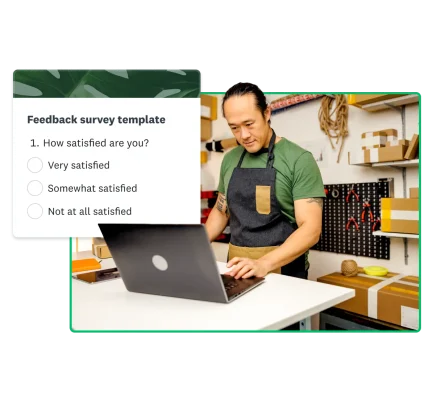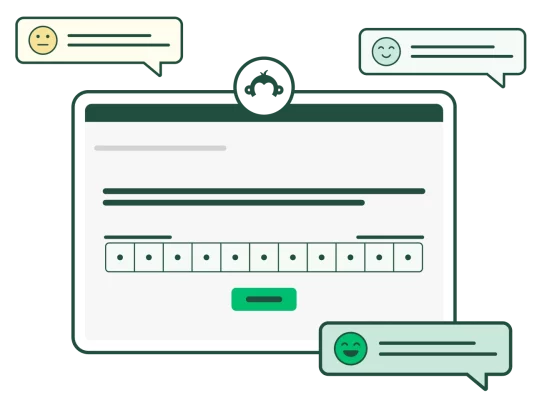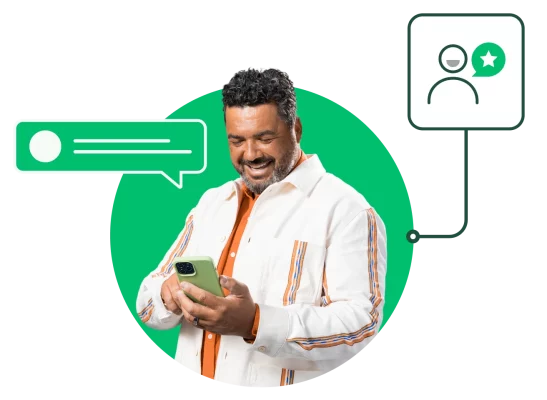Customer satisfaction survey email templates & best practices
Discover tips, templates, and best practices for crafting effective customer satisfaction emails.

- Email is one of the most effective channels for distributing customer satisfaction surveys.
- A clear and compelling email can increase response rates.
- A survey email includes an eye-catching subject line, personalization, a direct call to action, and a transparent purpose.
If you’re wondering whether your customers are happy, it’s time to stop guessing and start capturing your customer’s feedback with customer satisfaction (CSAT) surveys. Customer satisfaction surveys are a powerful tool to understand your customer sentiment and improve your business performance.
There are many different ways you can distribute a satisfaction survey to your existing customers. However, one of the most effective channels for conducting these surveys is still good old email.
In this article, we'll explore how to craft compelling customer satisfaction survey emails, what elements to include in the email to drive the highest response rate, and email templates to help you get started.
Customer satisfaction survey email templates

Customer satisfaction score survey email template
If you’re sending out a customer satisfaction score survey, here’s a simple email template you can use to get more responses:
Subject Line: How Did We Do? Share Your Feedback
Email Body:
Hi [Name],
Thank you for choosing [Your Company]. We hope you had a great experience with us. To help us continue improving our services, we’d love to hear your feedback.
Please take a moment to complete our short survey and let us know how we did.
[Start Survey Button]
Thank you for your time!
Best regards,
[Your Name]
[Your Position]
[Your Company]
Don’t have a CSAT survey yet? Get started with a free CSAT Survey Template.
Net Promoter Score® (NPS) survey email template
If you’re sending out a NPS survey, use this email template to get started:
Subject Line: We Value Your Opinion – Take Our NPS Survey
Email Body:
Hi [Name],
At [Your Company], your feedback is crucial to helping us grow and improve. We’d appreciate it if you could take a few minutes to answer a quick question about your experience with us.
On a scale of 0 to 10, how likely are you to recommend us to a friend or colleague?
[Start Survey Button]
Your input is greatly valued and will help us serve you better.
Thank you for your time!
Sincerely,
[Your Name]
[Your Position]
[Your Company]
Don’t have a NPS survey yet? Get started with a free NPS Survey Template.
Event satisfaction survey email template
Event satisfaction surveys can help you improve your future events and ensure satisfaction. Use this survey email template to get started:
Subject Line: Tell Us About Your Experience at [Event Name]
Email Body:
Hi [Name],
Thank you for attending [Event Name]! We hope you enjoyed it. To help us improve future events, we’d love to hear your feedback.
Please take a few minutes to complete our event satisfaction survey.
[Start Survey Button]
We appreciate your input and look forward to hosting you again.
Best regards,
[Your Name]
[Your Position]
[Your Company]
Don’t have an event survey yet? Get started with our free Event Feedback Survey Template.
How to send a customer satisfaction survey via email

Sending a customer satisfaction survey via email involves several key steps to ensure high engagement and response rates. Here's a step-by-step guide to sending customer satisfaction surveys via email.
1. Segment your audience
Always start with audience segmentation. Blasting a survey to your whole email list might seem like a good idea to get the max responses possible with little effort. But if you don’t segment your audience effectively, you won’t get the information you need to make informed decisions.
Instead, start by taking a close look at your customer base and consider which segments you want to survey first. For example, you might decide to survey recent purchasers, long-term customers, or users of a specific product or service. Then, you can send targeted satisfaction surveys to each segment to understand their unique perspectives on your business, product, and/or service.
2. Craft a clear, compelling email
We’ll get more in the weeds on what to include in your survey emails in the next section. In general, you’ll want to make sure your email is extremely clear and to-the-point. Including extraneous information or unnecessary details will distract the reader and lower your survey response rate. Focus on creating a compelling subject line to drive open rates and clear instructions on how to take the survey.
3. Follow up
Think you can send one email and that’s it? Think again! People are busy and they may not see the first email. Even if they do see it, they might think they’ll respond later and then forget to do so. To maximize your response rates, plan to send a follow-up email to remind recipients to complete the survey if they haven’t done so within a certain timeframe.
You’ll also want to send a thank you email to those who complete your survey to show your appreciation and continue to nurture the relationships with those customers.
Related reading: Sending surveys via email invitation
What to include in a customer satisfaction survey email
Now, let’s take a look at best practices for what to include in the customer satisfaction survey email itself. These should be short and to the point—so every word counts!
A compelling subject line
The subject line is your best chance to get the attention of your customers. The subject line is the first thing recipients see. It’s the only thing they have to go off of to decide whether to open your email at all. The subject line should grab the recipient’s attention and entice them to open the email.
Here are a few examples of effective subject lines:
- Help Us Improve – Share Your Feedback!
- We Value Your Opinion – Take Our Survey
- Your Feedback Matters – Complete Our Short Survey
These examples are short, catchy—and they’re clear about the ask—all of which can help improve your open rate and survey response rate.
Personalization
A generic email will likely fall flat, so use the recipient’s name and relevant details to make the email feel personalized and relevant to your customer. This can be done easily and automatically with most email service providers.
For example, in the subject line and/or body of the email, consider using specific personalized language like these examples:
- Hi [Name], we’d love to hear your thoughts!
- Dear [Name], your feedback is important to us.
It can also help to have the email come from a real, specific person in your company.
A clear call to action (CTA)
Make sure to add a clear call to action—and just one! Don’t clutter the email with extra unnecessary links. Be sure to include clear instructions on how to access and complete the survey.
- Click here to start the survey
- Take our 5-minute survey now
Provide specific instructions on accessing the survey and include the survey link prominently in the email. You might also add a qualifier giving the customer an idea of how long the survey will take them to complete. For example, “take this brief 5-question survey” or “Give us your feedback—it should take just 1 minute!”
Transparent explanation of the survey’s purpose
Help your customers help you by clearly explaining the reasoning beyond the survey and what you need from them to make informed decisions to improve their experience. Keep your messaging clear, succinct, and transparent. Explain why you’re conducting the survey and how their feedback will be used.
Customer satisfaction survey email FAQs
Why should I use email to send customer satisfaction surveys?
Email remains one of the most effective channels for reaching a broad audience and obtaining detailed feedback from your customers. It allows you to personalize your message, provide clear instructions, and follow up easily to maximize response rates.
What are the key elements of effective survey emails?
Key elements include a compelling subject line, personalization, a clear call to action, a transparent explanation of the survey’s purpose, and concise, relevant content that encourages recipients to participate.
How can I improve the open rate of my survey emails?
Improve your open rates by crafting engaging and intriguing subject lines, personalizing the email, and ensuring the sender name is recognizable and trusted by the recipient.
What should I include in the subject line?
Your subject line should be short, catchy, and clearly convey the purpose of the email. Examples include: "Help Us Improve – Share Your Feedback!" or "Your Opinion Matters – Take Our Survey."
How can I personalize my customer satisfaction survey email?
Use the recipient’s name in the greeting and subject line, and tailor the content to their specific interactions with your brand. You can also mention relevant details such as their recent purchase or event attendance.
What is the best way to format the call-to-action in my survey email?
Your CTA should be prominent, clear, and concise. Use action-oriented language such as "Click here to start the survey" or "Take our 5-minute survey now." Place the CTA button in a noticeable spot within the email.
How long should my customer satisfaction survey email be?
Keep your email short and to the point. Include only essential information to avoid overwhelming the reader. A concise email is more likely to be read and acted upon.
How many follow-up emails should I send?
It is generally effective to send one or two follow-up emails. Space them out appropriately, giving recipients enough time to respond to the initial email before sending a reminder.
How can I explain the purpose of the survey in my email?
Be transparent about why you are conducting the survey and how the feedback will be used. A brief explanation can motivate customers to participate, as they see the value in sharing their opinions.
What should I do with the feedback from customer satisfaction surveys?
Analyze the feedback to identify trends and areas for improvement. Use the insights to make informed decisions that enhance customer experience. It’s also important to communicate back to customers about changes made based on their feedback.
Monitor and improve customer satisfaction with SurveyMonkey
When executed effectively, customer satisfaction surveys can give you invaluable insights into what customers think about your products or services and help you identify areas for improvement to improve your overall customer experience.
Creating effective customer satisfaction survey emails is crucial for gathering valuable feedback and improving customer experiences. Use the guidelines, templates, and examples above to craft compelling emails that encourage high response rates and drive actionable insights.
Learn more or get started with a free CSAT template.
Net Promoter, Net Promoter Score, and NPS are trademarks of Satmetrix Systems, Inc., Bain & Company, Inc., and Fred Reichheld.
Discover more resources

Customer satisfaction survey templates
Explore our customer satisfaction survey templates to rapidly collect data, identify pain points, and improve your customer experience.

See how Aptive gathers critical Veteran insights
Discover how Aptive uses SurveyMonkey to collect critical Veteran insights to improve federal government services and Veteran experiences.

Hornblower enhances global customer experiences
Discover how Hornblower uses SurveyMonkey and powerful AI to make the most of NPS data, collect customer insights, and improve customer experiences.

Ultimate Customer Satisfaction Guide: 8 Tactics to Improve
What is customer satisfaction? Learn what it is, how to measure customer satisfaction, and 8 strategies for business success with this complete guide.